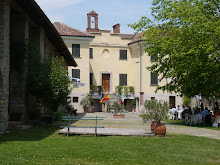
Oggi esce il nostro primo
OVADA a denominazione di origine controllata e
garantita :
il BRICCO RICCARDO 2008 Il Dolcetto di Ovada Superiore o Ovada è diventato DOCG con decreto del 6 luglio 2005 e pubblicazione sulla gazzetta ufficiale n. 1229 del 30 settembre 2008.
I PUNTI PIU' IMPORTANTI DELLA MODIFICA DEL DISCIPLINARE SONO I SEGUENTI:Il disciplinare prevede la possibilità di avre queste tipologie:
«Dolcetto di Ovada Superiore» o «Ovada»;
«Dolcetto di Ovada Superiore» o «Ovada» «riserva»;
«Dolcetto di Ovada Superiore» o
«Ovada» «vigna»;«Dolcetto di Ovada Superiore» o «Ovada» «vigna» «riserva».
I terreni utilizzati dovranno essere argillosi, tufacei, calcarei e loro eventuali combinazioni, compresi quelli a medio impasto, esclusivamente collinari con un’altitudine non superiore ai 600 m. s.l.m..
I vigneti oggetto di nuova iscrizione o di reimpianto dovranno essere composti da un numero di ceppi ad ettaro, calcolati sul sesto d'impianto non inferiore a 4000. La forma di allevamento dovrà essere a controspalliera con legatura della vegetazione verde sempre al di sopra del capo a frutto e sistema di potatura Guyot tradizionale e comunque atto a non modificare le caratteristiche delle uve e del vino.
La resa massima prevista è di 6 t. per ettaro.
Dolcetto di Ovada Superiore o Ovada; vitigno dolcetto 100%, titolo alcolometrico volumico minimo totale 12,5%, affinamento minimo 12 mesi.
Dolcetto di Ovada Superiore o Ovada riserva; vitigno dolcetto 100%, titolo alcolometrico volumico minimo totale 12,5%, affinamento minimo 24 mesi.
Dolcetto di Ovada Superiore o
Ovada vigna; vitigno dolcetto 100%, titolo alcolometrico volumico minimo totale 13%, affinamento minimo 12 mesi.
Dolcetto di Ovada Superiore o Ovada vigna riserva; vitigno dolcetto 100%, titolo alcolometrico volumico minimo totale 13%, affinamento minimo 24 mesi.
L’inserimento del nome della vigna è previsto solo se la vigna ha un’età di almeno 7 anni.
Today comes out the first OVADA designation of origin and guaranteed: the BRICCO RICCARDO 2008
Dolcetto di Ovada Superiore or Ovada became DOCG by decree of July 6, 2005 and published in the Official Journal 1229 September 30, 2008.
The most important points of modification are:
The disciplinary provides for the possibility of these types:
"Dolcetto di Ovada Superiore" or "Ovada;
"Dolcetto di Ovada Superiore" or "Ovada" riserva
"Dolcetto di Ovada Superior" or "Ovada" vigna ";
"Dolcetto di Ovada Superior" or "Ovada" vigna "riserva"
Land used to be clayey , tufaceous, calcareous, and their possible combinations, including those at medium consistency, only the hills with an altitude not exceeding 600 m. s.l.m..
Vineyards under new registration or replanting will be composed of a number of plants per hectare of at least 4000.
The maximum yield is 6 t. per hectare.
Dolcetto di Ovada Superiore or Ovada;
Dolcetto 100%,
minimum total alcohol by volume 12.5%
aged at least 12 months.
Dolcetto Superiore di Ovada Ovada or riserva; Dolcetto 100%,
minimum alcohol by volume is 12.5%,
aged at least 24 months.
Dolcetto di Ovada Superiore or Ovada vigna Dolcetto 100%,
minimum total alcoholic by volume 13%,
aged at least 12 months.
Dolcetto Superiore di Ovada or Ovada vigna riserva;
Dolcetto 100%,
minimum total alcohol by volume is 13%,
aged at least 24 months.
The inclusion of the name of the vineyard is only required if the vineyard has a minimum age of 7 years.









